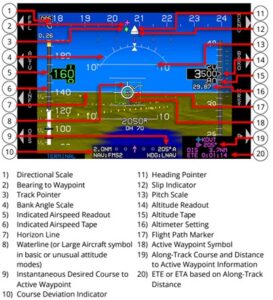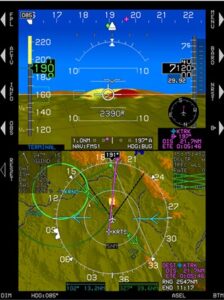
Genesys Blog
The Evolution of Aircraft Displays: From Analog Instruments to Digital EFIS Displays
Introduction
The Electronic Flight Instrument System (EFIS) is a crucial component of modern aircraft, providing pilots with essential flight information in real time utilizing intuitive formats. EFIS displays have revolutionized the aviation industry, offering numerous benefits over traditional analog displays and have become the de-facto cockpit technology today. This blog aims to explore the evolution of aircraft EFIS displays, from the era of analog displays to the rise of digital technology, and the impact it has had on pilots.
I. The Era of Analog Displays
Analog displays were the primary means of presenting flight information before the advent of digital technology from the late 1970’s and onward. Analog displays utilized physical mechanisms, such as mechanical gauges and dials, to indicate various flight parameters. While analog displays were reliable, they had limitations in terms of accuracy, flexibility, and ease of interpretation plus required frequent calibration and maintenance.
Analog cockpit displays were classified into three main categories: flight instruments, engine instruments, and navigation instruments.
Common analog flight instruments included the 1. airspeed indicator, 2. attitude indicator, 3. altimeter, 4. turn coordinator, 5. heading indicator, and 6. vertical speed indicator; commonly called “The Six-Pack”.

Pilots relied on their experience and interpretation skills to understand the information provided by analog displays.
II. The Transition to Digital Displays
The transition from analog to digital displays began in the late 1970s and early 1980s. Digital displays offered numerous benefits, including improved accuracy, flexibility, and ease of interpretation. Digital displays also required less calibration and maintenance.
Factors driving the transition included advancements in microprocessor technology, increased reliability of digital systems, and the need for more precise flight information. Early digital display technologies, such as cathode-ray tube (CRT) displays, had limitations in terms of size, weight, and power consumption.
Pilots faced challenges during the transition, including the need for training and familiarization with the new technology like any new technology entering the cockpit.
III. The Rise of EFIS Displays
EFIS displays represent a significant advancement in flight instrument technology. EFIS displays integrate multiple flight instruments into a single display unit, providing pilots with a comprehensive overview of flight parameters. Benefits of EFIS displays over traditional analog displays include improved situational awareness, reduced workload, and enhanced safety.

EFIS displays utilize digital technology to present flight information in a more intuitive and user-friendly manner. The integration of advanced features like synthetic vision and terrain awareness further enhanced the capabilities of EFIS displays for a more complete picture of situation awareness.

IV. Evolution of EFIS Display Technologies
Different types of EFIS displays have emerged over the years, including CRT, LCD, LED, and OLED displays. Advancements in display resolution, color, and brightness have significantly improved the readability and clarity of EFIS displays. The integration of touchscreen technology has further enhanced the user experience and ease of interaction with EFIS displays.
Advanced features like synthetic vision, which provides a 3D representation of the surrounding terrain, have become standard in modern EFIS displays.

V. Pilot Training and Transition to EFIS Displays
Pilots faced challenges during the transition to EFIS displays, including the need for training and familiarization with the new systems. Proper training and familiarization with EFIS systems are crucial to ensure pilots can effectively utilize the capabilities of these advanced displays. Training programs and resources are available to help pilots adapt to EFIS displays, including simulator-based training and online courses to ensure system familiarization and proper interpretation of information being displayed.
VI. Future Trends and Innovations
Ongoing research and development in EFIS display technology continue to drive innovation in the aviation industry. Potential advancements include the integration of augmented reality and head-up display technology, providing pilots with real-time information overlaid on their field of view.
Artificial intelligence and machine learning have the potential to further enhance EFIS displays by analyzing vast amounts of data and providing predictive information to the pilot helping to reduce workload in stressful conditions.
The future of EFIS displays holds exciting possibilities, with advancements in technology expected to improve safety, efficiency, and pilot situational awareness.
VII. Conclusion
The evolution of aircraft EFIS displays has transformed the way pilots interact with flight information.
EFIS displays offer numerous benefits over traditional analog displays, including improved accuracy, improved situational awareness, and reduced workload.
As technology continues to advance, the future of EFIS displays holds great promise for the aviation industry, with potential advancements in augmented reality, artificial intelligence, and machine learning.
VIII. Find Out More Information
For more information about Genesys EFIS products visit: Genesys Aerosystems EFIS Products.
To request more information for Genesys EFIS products for your aircraft contact us today.